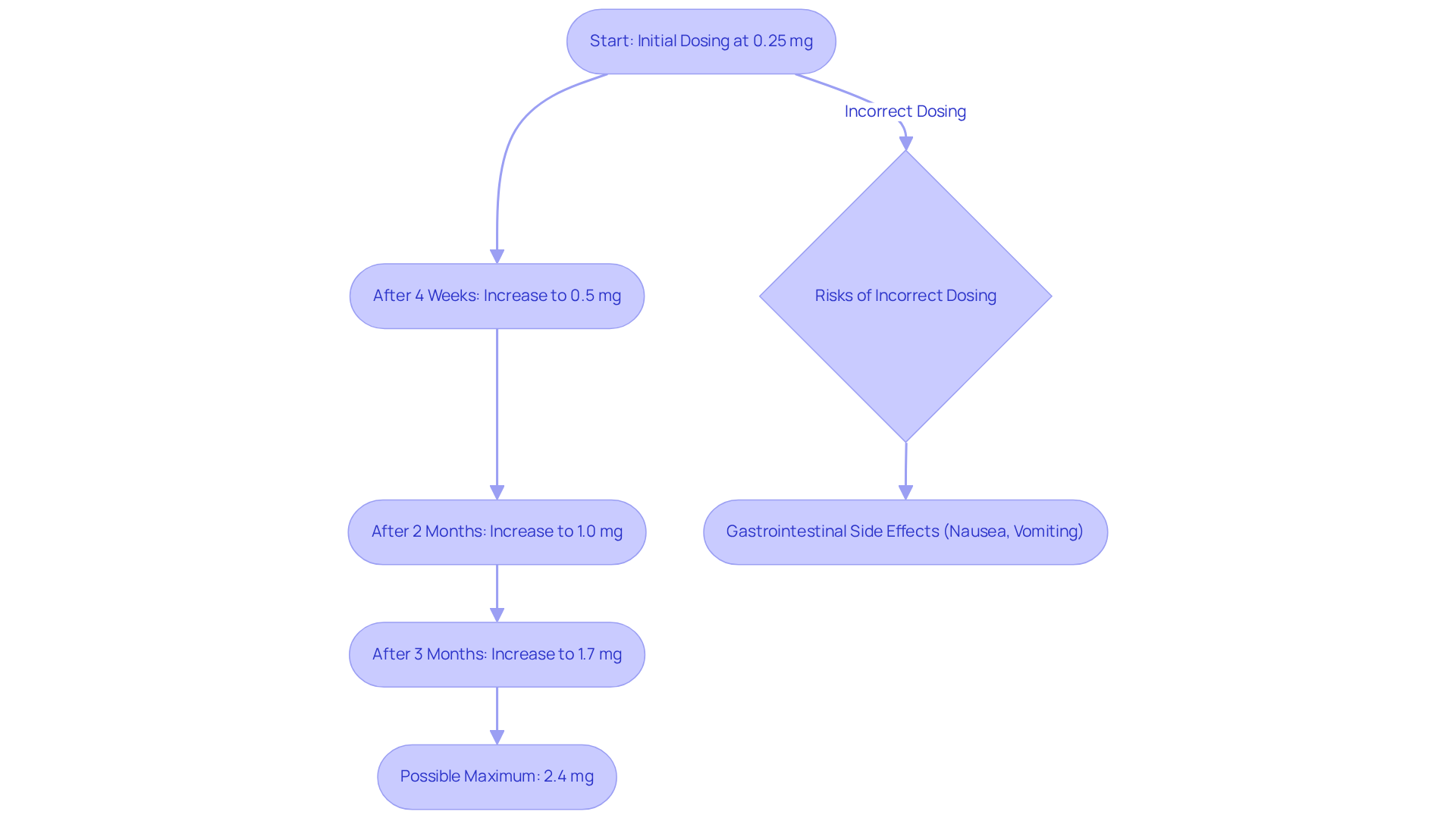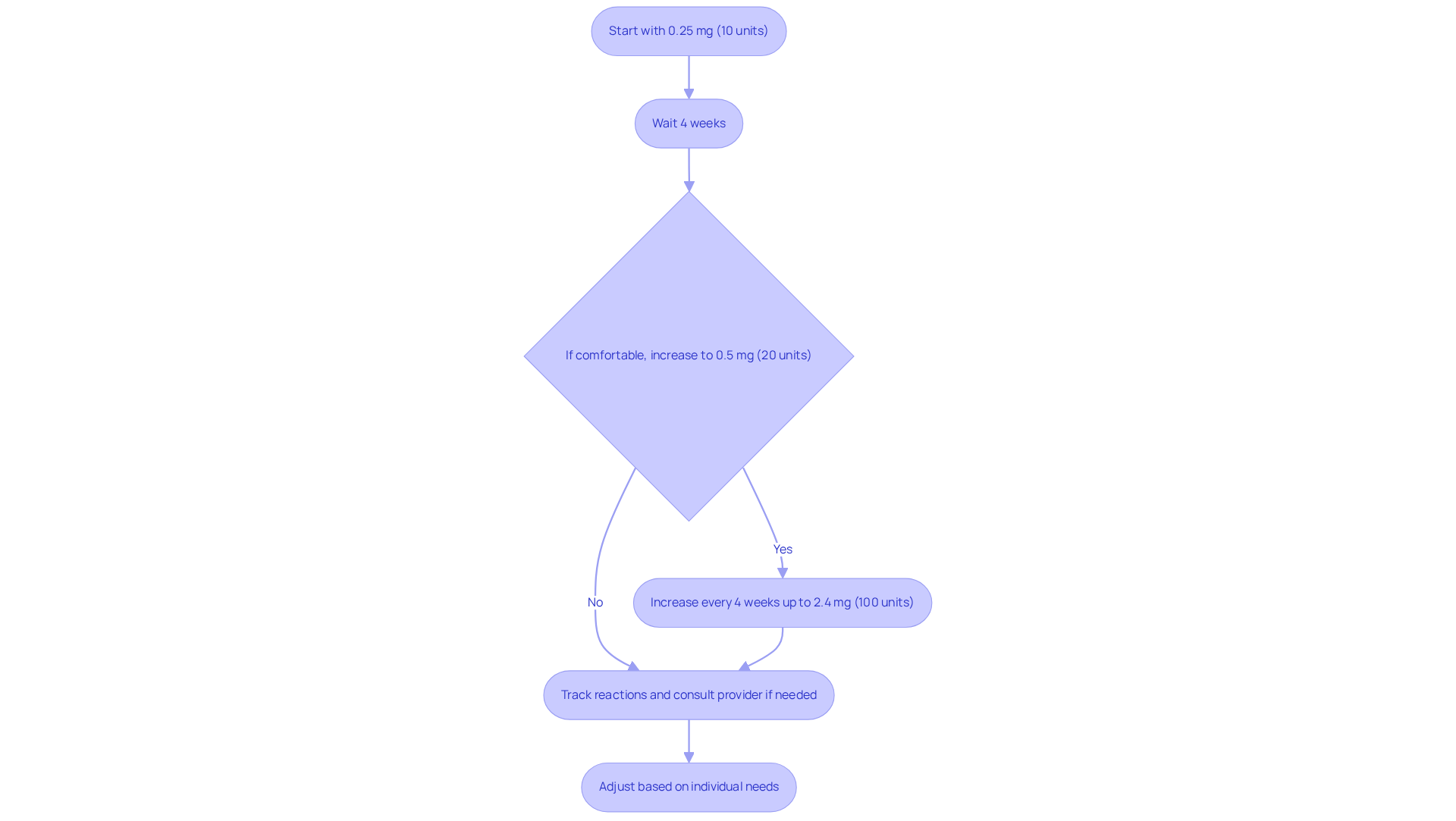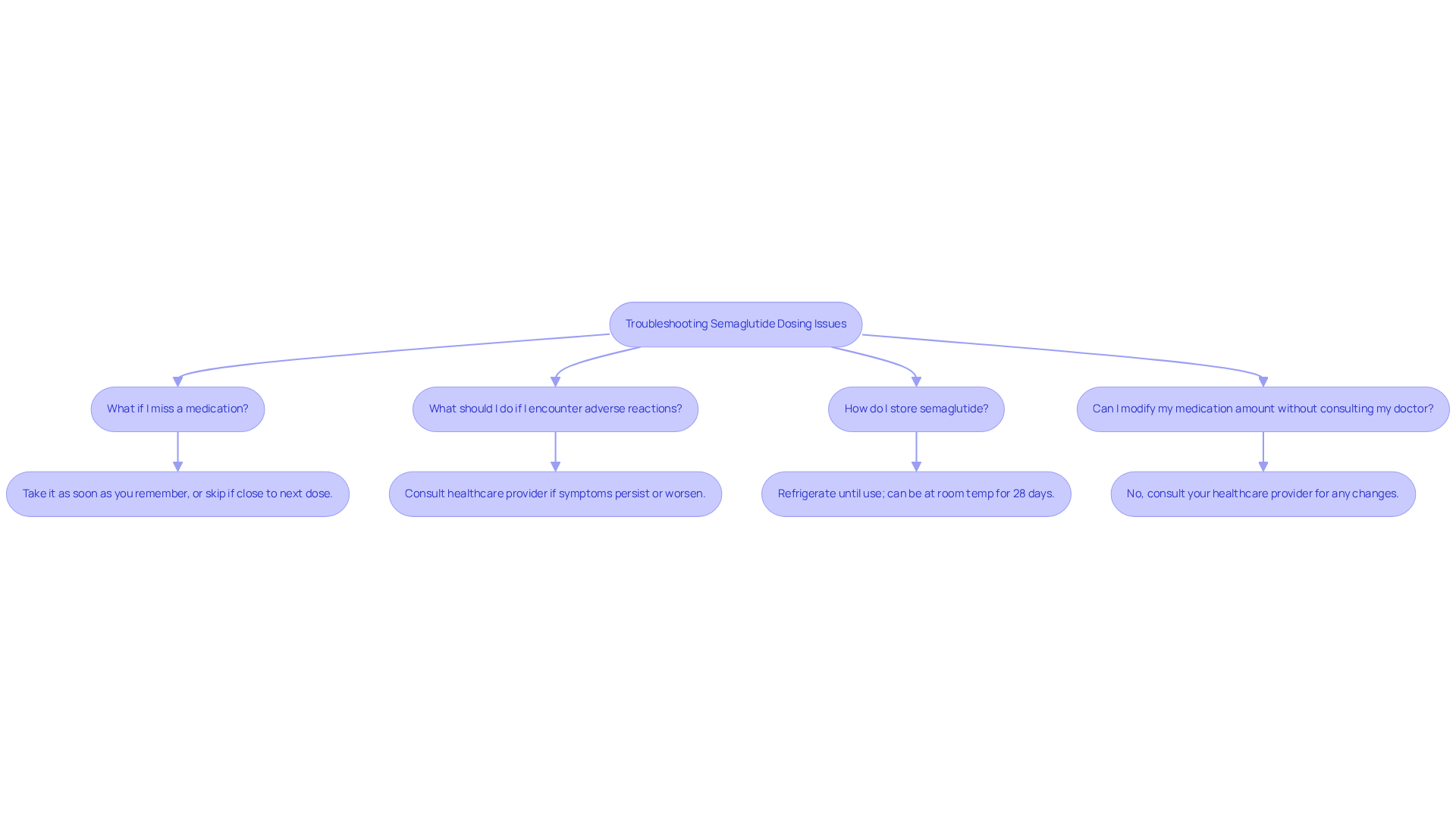Overview
This article addresses the journey of weight loss, focusing on the careful calculation of the ideal dose of semaglutide. We understand that navigating this path can feel overwhelming, and we want you to know that precise dosing is crucial for achieving the best results while minimizing any potential side effects. To support you, we outline a structured dosing schedule that starts with an initial dose of 0.25 mg and may increase to a maximum of 2.4 mg. Clinical evidence shows that significant weight loss outcomes are possible, especially when combined with lifestyle changes.
We’re here for you, and together, we can achieve your goals. As you consider this treatment, remember that each step you take is part of a larger journey. The structured approach we provide not only helps in understanding the dosing but also emphasizes the importance of lifestyle adjustments. This holistic view can empower you to make lasting changes.
Have you thought about how small, consistent changes can lead to big results? By focusing on both the medication and your lifestyle, you can create a supportive environment for your weight loss journey. We encourage you to reflect on your habits and think about what changes you can implement alongside this treatment.
In conclusion, we believe in your ability to succeed. With the right support and a well-planned approach, you can experience the positive outcomes of semaglutide. Remember, you are not alone in this; we’re here to support you every step of the way.
Introduction
Navigating the complexities of weight management can feel overwhelming, especially when considering the role of medications like semaglutide. This innovative treatment, a glucagon-like peptide-1 (GLP-1) receptor agonist, has shown remarkable potential in supporting weight loss by regulating appetite and glucose metabolism. However, understanding the intricacies of dosing is crucial—it can significantly impact both results and safety.
How can you ensure that you are calculating your ideal semaglutide dose effectively to maximize benefits while minimizing risks? Together, we can explore this journey toward a healthier you.
Understand Semaglutide and Its Role in Weight Loss
If you’re navigating the challenges of weight management, considering semaglutide dosing for weight loss in units might be a helpful ally on your journey. This medication is a glucagon-like peptide-1 (GLP-1) receptor agonist that mimics the natural hormone GLP-1, which plays a vital role in regulating appetite and glucose metabolism. By enhancing insulin release and slowing gastric emptying, Semaglutide effectively reduces appetite and promotes a sense of fullness.
This mechanism can be especially beneficial for those dealing with obesity, as semaglutide dosing for weight loss in units has demonstrated the potential for significant weight loss when combined with lifestyle changes like a balanced diet and regular exercise. Clinical studies reveal that individuals using Semaglutide can experience an average reduction of about 15.2% in body mass at week 104, compared to only 2.6% in the placebo group. Remarkably, around 70% of participants in the treatment group achieved a loss of at least 10% of their weight, and 77.1% saw a minimum reduction of 5% with the use of semaglutide dosing for weight loss in units.
However, it’s important to approach this treatment with awareness. Some individuals in the treatment group reported gastrointestinal adverse events, which should be carefully considered when evaluating the overall safety profile. Yet, the encouraging findings underscore the potential of semaglutide dosing for weight loss in units to enhance health outcomes for those struggling with body mass management.
At Minimal, many of our clients have experienced remarkable success, with some losing up to 20% of their mass based on data from over 70,000 patients. Remember, you’re not alone on this journey. Together, we can achieve your goals and improve your health outcomes. We’re here for you, every step of the way.
Recognize the Importance of Accurate Dosing
Understanding the importance of precise dosing can be a key factor in your weight loss journey. It’s crucial for achieving optimal results and minimizing any unwanted side effects. The FDA-approved initial semaglutide dosing for weight loss in units is 0.25 mg, administered once a week. This starting point allows your body to gradually adjust to the medication. After four weeks, many find it beneficial to increase the dose of semaglutide dosing for weight loss in units to 0.5 mg, followed by 1.0 mg in the third month, and potentially reaching 1.7 mg in the fourth month. For some, the maximum semaglutide dosing for weight loss in units may reach up to 2.4 mg weekly, depending on how well you respond and tolerate the treatment.
However, it’s important to be aware that incorrect dosing can lead to significant side effects, especially gastrointestinal issues like nausea and vomiting. In clinical trials, these side effects have contributed to discontinuation rates of up to 8%, which can hinder your weight loss progress. This is why sticking to the prescribed dosing schedule is so vital. If you feel that adjustments are needed, please reach out to your healthcare provider. We’re here for you, and together, we can ensure your treatment is both safe and effective.
Additionally, remember that incorporating lifestyle changes—such as a lower-calorie diet and regular exercise—alongside your treatment can lead to even better outcomes. You’re not alone in this journey; many have found success by making these adjustments. Let’s take this step together, and remember, every small change counts towards achieving your goals!
Calculate Your Ideal Semaglutide Dose in Units
Calculating your ideal semaglutide dose can feel overwhelming, but we’re here to help you through it. To start, determine your starting amount. Begin with the FDA-recommended quantity of 0.25 mg, which corresponds to 10 units on a standard insulin syringe. This initial step is crucial for setting a solid foundation for your journey.
Next, follow the titration schedule. After four weeks, if you feel comfortable, you can raise your dosage to 0.5 mg (20 units). Continue to adhere to this schedule, increasing your amount every four weeks as necessary, up to a maximum of 2.4 mg (100 units). By Week 17, the maintenance dose of semaglutide is 2.4 mg subcutaneously once a week. This gradual increase is essential for minimizing side effects and enhancing your weight loss outcomes.
As you progress, it’s important to track your reactions. Keep a record of your weight loss journey and any side effects you may experience. Clinical data shows that many individuals can lose up to 20% of their weight with this structured approach, with an average weight reduction of 15% over a year and a half. If you encounter significant adverse reactions, please consult your healthcare provider before increasing your dosage. It’s worth noting that 4% to 17% of participants in clinical trials of Wegovy stopped the medication due to notable gastrointestinal side effects.
Lastly, adjust based on your individual needs. Your healthcare provider may suggest modifications based on your weight loss goals, tolerance, and any underlying health conditions. Always double-check that you are using the correct syringe and dosage markings to avoid errors. As Dr. Beverly Tchang, an Obesity Medicine Advisor, wisely states, “Determining which is better depends on individual health goals, existing conditions, and how one’s body responds to treatment.” This personalized approach is vital for achieving optimal results while ensuring your safety. Remember, together, we can achieve your goals.
Troubleshoot Common Dosing Issues and Questions
When using semaglutide, it’s common to face some challenges related to semaglutide dosing for weight loss in units. Let’s address some frequently asked questions with care and understanding:
-
What if I miss a medication? If you forget a dose, take it as soon as you remember. However, if it’s nearly time for your next dose, it’s best to skip the missed one and return to your regular schedule. Please avoid taking multiple doses at once, as this may lead to increased reactions, including heightened appetite and potential weight regain.
-
What should I do if I encounter adverse reactions? Common symptoms, such as nausea and gastrointestinal distress, are reported by about 44.2% of participants in clinical studies, making nausea the most frequently noted negative occurrence. If these symptoms persist or worsen, please consult your healthcare provider for guidance on managing them or adjusting your medication. Many patients find that gradually increasing their semaglutide dosing for weight loss in units, with their provider’s support, can help alleviate these effects.
-
How do I store semaglutide? Store the medication in the refrigerator until you’re ready to use it. Once in use, it can be kept at room temperature for up to 28 days. It’s important to avoid exposing it to extreme temperatures, as this can affect its effectiveness.
-
Can I modify my medication amount without consulting my doctor? No, any changes to your semaglutide dosing for weight loss in units should be made under the supervision of your healthcare provider to ensure your safety and the medication’s effectiveness. This is especially crucial if you’ve experienced side effects or missed doses, as improper adjustments can lead to adverse reactions or reduced weight loss results.
Remember, we’re here for you every step of the way. Together, we can achieve your goals.
Conclusion
Navigating the complexities of semaglutide dosing for weight loss can be a daunting journey, but it’s one that can significantly impact your success. This medication is recognized for its ability to regulate appetite and support metabolic health, offering a structured approach that can lead to substantial weight loss when used correctly and alongside lifestyle changes. Understanding the nuances of dosing is essential for maximizing benefits while minimizing potential side effects.
Throughout this article, we’ve shared key insights regarding the dosing schedule, starting with the FDA-approved initial dose of 0.25 mg and gradually increasing based on your individual response and tolerance. The importance of adhering to this schedule cannot be overstated; improper dosing can lead to adverse gastrointestinal reactions that may hinder your weight loss progress. Additionally, tracking your weight loss journey and communicating with healthcare providers enhances the likelihood of achieving your personal health goals.
Ultimately, your journey with semaglutide is not just about the medication itself, but about fostering a holistic approach to weight loss that includes lifestyle modifications and support systems. For anyone considering or currently using semaglutide, it is crucial to engage actively with healthcare professionals, stay informed about dosing guidelines, and remain committed to your personal health objectives. Together, we can harness the full potential of this treatment and work towards a healthier future. Remember, we’re here for you every step of the way.
Frequently Asked Questions
What is semaglutide and how does it work for weight loss?
Semaglutide is a glucagon-like peptide-1 (GLP-1) receptor agonist that mimics the natural hormone GLP-1. It works by enhancing insulin release, slowing gastric emptying, reducing appetite, and promoting a sense of fullness, which can aid in weight management.
What kind of weight loss results can be expected with semaglutide?
Clinical studies have shown that individuals using semaglutide can experience an average weight reduction of about 15.2% after 104 weeks, compared to only 2.6% in the placebo group. Approximately 70% of participants in the treatment group achieved at least a 10% weight loss, and 77.1% experienced a minimum reduction of 5%.
Are there any side effects associated with semaglutide?
Yes, some individuals in the treatment group reported gastrointestinal adverse events. It’s important to consider these potential side effects when evaluating the overall safety profile of semaglutide.
How does semaglutide work best for weight loss?
Semaglutide is most effective when combined with lifestyle changes, such as a balanced diet and regular exercise, to enhance its weight loss effects.
What success have clients experienced with semaglutide at Minimal?
Many clients at Minimal have reported significant success, with some losing up to 20% of their body mass, based on data from over 70,000 patients.





















